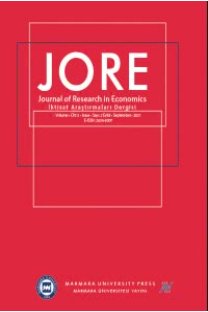DÜNYADA VE TÜRKİYE’DE SERBEST BÖLGELER
Bu çalışma “serbest bölge”nin genel kabul görmüş tanımından hareketle dünyada ve Türkiye’de serbest bölgelerin farklılaşan biçimlerini incelemektedir. Serbest bölgelerin kurulma amaçları ve bu amaçlara ne ölçüde ulaştıklarına dair değerlendirmeler yapmaktadır. Serbest bölgelere bütüncül bir yaklaşım yerine sermaye kesimleri açısından yaklaşmanın önemine değinmektedir. Bu bakımdan, özellikle sınai üretim faaliyetlerini içeren serbest bölgelere odaklanılarak, bu bölgeler 1960’lardan beri yaşanan küresel ekonomik değişimler bağlamında değerlendirilmektedir. Ayrıca çalışmada, serbest bölgelerde sermaye–emek ilişkilerinin nasıl konumlandığı tartışılmaktadır. Son olarak araştırma, Türkiye’deki serbest bölgelere dair kısa bir değerlendirme içermektedir.
Anahtar Kelimeler:
Serbest bölgeler, Serbest ticaret bölgeleri, Türkiye ekonomisi, sektörel çeşitlenme
___
- Chen, X. (1994). The Changing Role of Free Economic Zones in Development: A Comparative Analysis of Capitalist and Socialist Cases in East Asia. Studies in Comparative International Development, 29 (3): 3-25.
- Devereux, J. & Chen, L.L. (1995). Export Zones and Welfare: Another Look. Oxford Economic Papers, 47(4): 704–714.
- Dünya Bankası (DB) (2008). Special Economic Zones ─ Performance, Lessons Learned, and Implications for Zone Development, Washington, DC, Nisan.
- Erdoğan, E. ve Ener, M. (2005). Küresel Pazarların Ekonomik Üsleri-Serbest Bölgeler, Ankara: Nobel Yayın.
- Ge, W. (1999). Special Economic Zones and the Opening of the Chinese Economy: Some Lessons for Economic Liberalization. World Development, 27(7), temmuz.
- Graham, E. (2004). Do export processing zones attract FDI and its benefits: the experience from China. International Economics and Economic Policy, 1 (1): 87-103.
- Gültekin-Karakaş, D. and Acar, S. (2011). Sectoral Transformation of Turkish Free Zones. İktisat, İşletme ve Finans, 26 (305): 57-84.
- Hamada, K. (1974). An Economic Analysis of the Duty Free Zon. Journal of International Economics, 4: 225-4.
- Hamilton, C. ve Svensson, L. E.O. (1982). On the Welfare Effects of a Duty-Free Zone. Journal of International Economics, 13 (1-2): 45-64.
- ICFTU (2003). Annual Survey on Trade Union Rights Violations. URL: http://www.icftu.org
- ILO (2002). Employment and Social Policy in Respect of Export Processing Zones (EPZs). Committee on Employment and Social Policy, Geneva: ILO.
- ILO (2007). ILO Database on Export Processing Zones, URL: http://www.ilo.org/public/english/dialogue/sector/themes/epz/epz-db.pdf
- Johansson, H. (1994). The economics of export processing zones revisited. Development Policy Review, 12(4): 387–402
- Johansson, H. ve Nilsson, L. (1997). Export processing zones as catalysts. World Development, 25 (12): 2115-28.
- Kaplinsky, R. (1993). Export Processing Zones in the Dominican Republic: Transforming Manufactures into Commodities. World Development, 21 (11): 1851-65.
- Matsuo Kei, M. (1977). The Working Class in the Masan Free Export Zone. Free Trade Zones and Industrialization of Asia, 8 (4).
- Kreye, O., Heinrichs, J., ve Frobel, F. (1987). Export Processing Zones in Developing Countries: Results of a New Survey. Multinational Enterprises Programme No.43. Geneva: ILO.
- McIntyre, J.R., Narula, R. ve Trevino, L.J. (1996). The Role of Export Processing Zones for Host Countries and Multinationals: A Mutually Beneficial Relationship? The International Trade Journal, 10 (4).
- Miyagiwa, K. (1986). A Reconsideration of the Welfare Economics of the Free Trade Zone. Journal of International Economics, 21: 337-50.
- Morello, T. (1983). Sweatshops in the sun? Far Eastern Economic Review (September 5): 88-89.
- Öztürk, L. (2003). Avrupa Birliği Sürecinde Serbest Bölgeler. Dış Ticaret Dergisi, 28 (Nisan 2003): 61-76.
- Pearce, R. (2008). Multinationals’ Strategies and the Economic Development of Small Economies: A Tale of Two Transitions. Management International Review, 49 (1): 81-94, Şubat.
- Romer, P. M. (1993). Two Strategies for Economic Development: Using Ideas and Producing Ideas. World Bank Conference on Development Economics, s. 63-92.
- Safa, H. I. (1986). Runaway Shops and Female Employment: The Search for Cheap Labor. in Eleanor Leacock and Helen I. Safa, Women's Work. Bergin & Garvey, 1986.
- Spinanger, D. (1984). Objectives and impact of economic activity zones — Some evidence from Asia. Review of World Economics (Weltwirtschaftliches Archiv), Springer, vol. 120(1): 64-89, Mart.
- Tekeli, İ. ve İlkin, S. (1987). Dünyada ve Türkiye'de Serbest Üretim Bölgelerinin Doğuş ve Dönüşümü. Yurt Yayınları, Ankara.
- Tüzmen, K. (2003). Serbest Bölgelerin Ekonomiye Katkısı Artacak. Serbest Bölge, İstanbul Trakya Serbest Bölge Yayını, Kış: 4-6.
- UNCTAD (1993). World Investment Report, Geneva.
- Vernon, R. (1966). International Investment and International Trade in Product Cycle. Quarterly Journal of Economics 80: 190-207.
- Warr, P.G. (1987). Malaysia's Industrial Enclaves: Benefits and Costs. Developing Economies, 25(1): 30–55.
- Warr, P. (1989). Export Processing Zones: The Economics of Enclave Manufacturing. World Bank Research Observer, 4 (1): 65-88.
- Willmore, L. (1995). Export Processing Zones in the Dominican Republic: A Comment on Kaplinsky. World Development, 23 (3): 529-35.
- Young, L. (1992). Unemployment and the optimal export-processing zone. Journal of Development Economics, 37: 369-85.
- Yüksel, S. (2005). Cari Açığın Faili Bulundu. Yeni Para, 4-10/9: 34-35
- ISSN: 2636-8307
- Başlangıç: 2016
- Yayıncı: Marmara Üniversitesi
Sayıdaki Diğer Makaleler
DISTRIBUTIONAL DYNAMICS OF REGIONAL INCOMES IN TURKEY: 1987-2014
TÜRKİYE’NİN 1990-2015 DÖNEMİNDEKİ EKONOMİK PERFORMANSI ÜZERİNE BİR DEĞERLENDİRME
PLANLI DÖNEMDE KIRSAL KALKINMA BAĞLAMINDA BİR GİRİŞİM: TÜRKİYE SÜT ENDÜSTRİSİ KURUMU (1963-1995)
THE EFFECTS OF ENERGETIC TRANSITION ON ECONOMIC GROWTH IN IRAN
Nathalie HILMI, Alain SAFA, Shekoofeh FARAHMAND, Majid SAMETI, Salahaldin SASSAN
